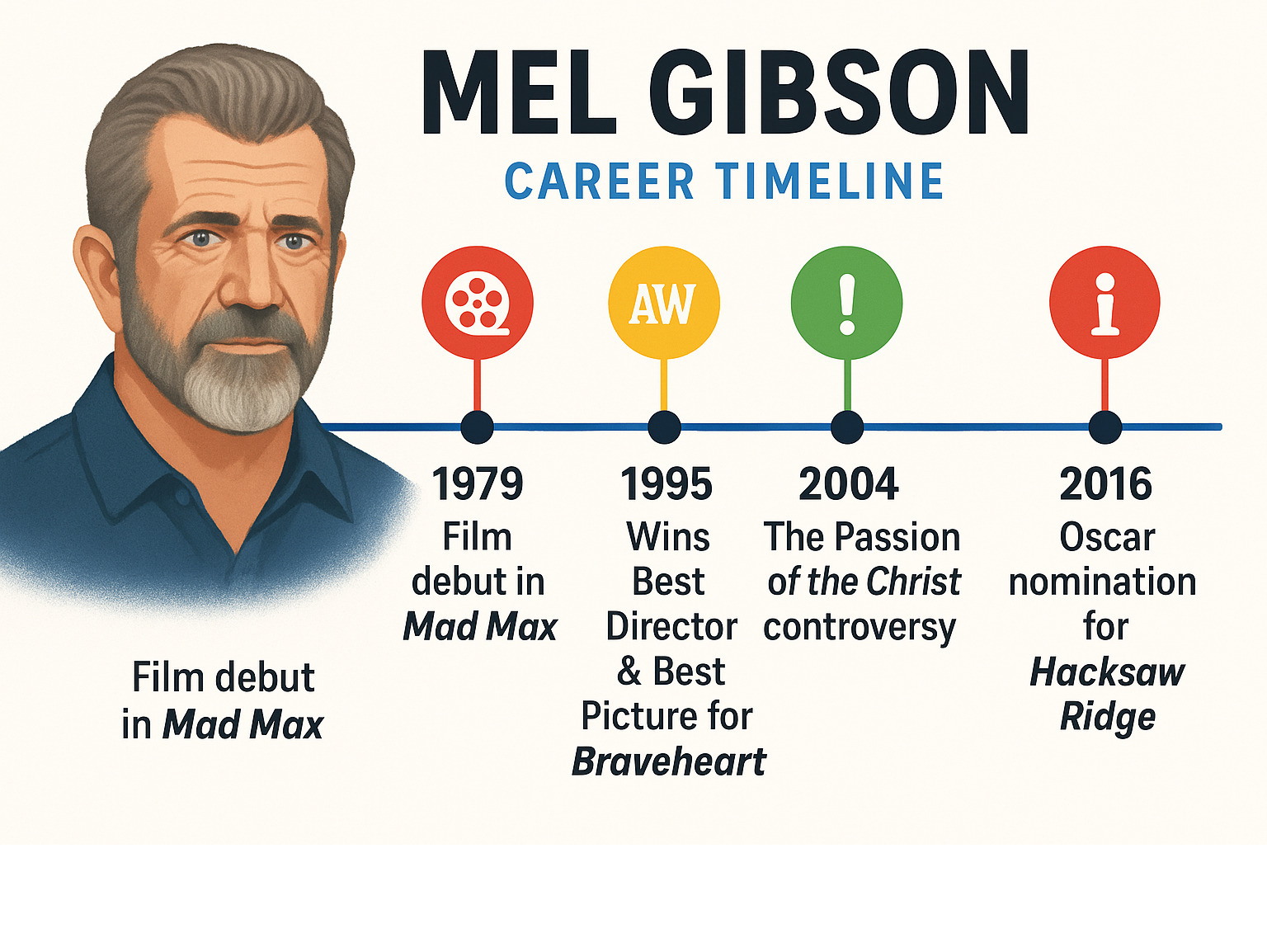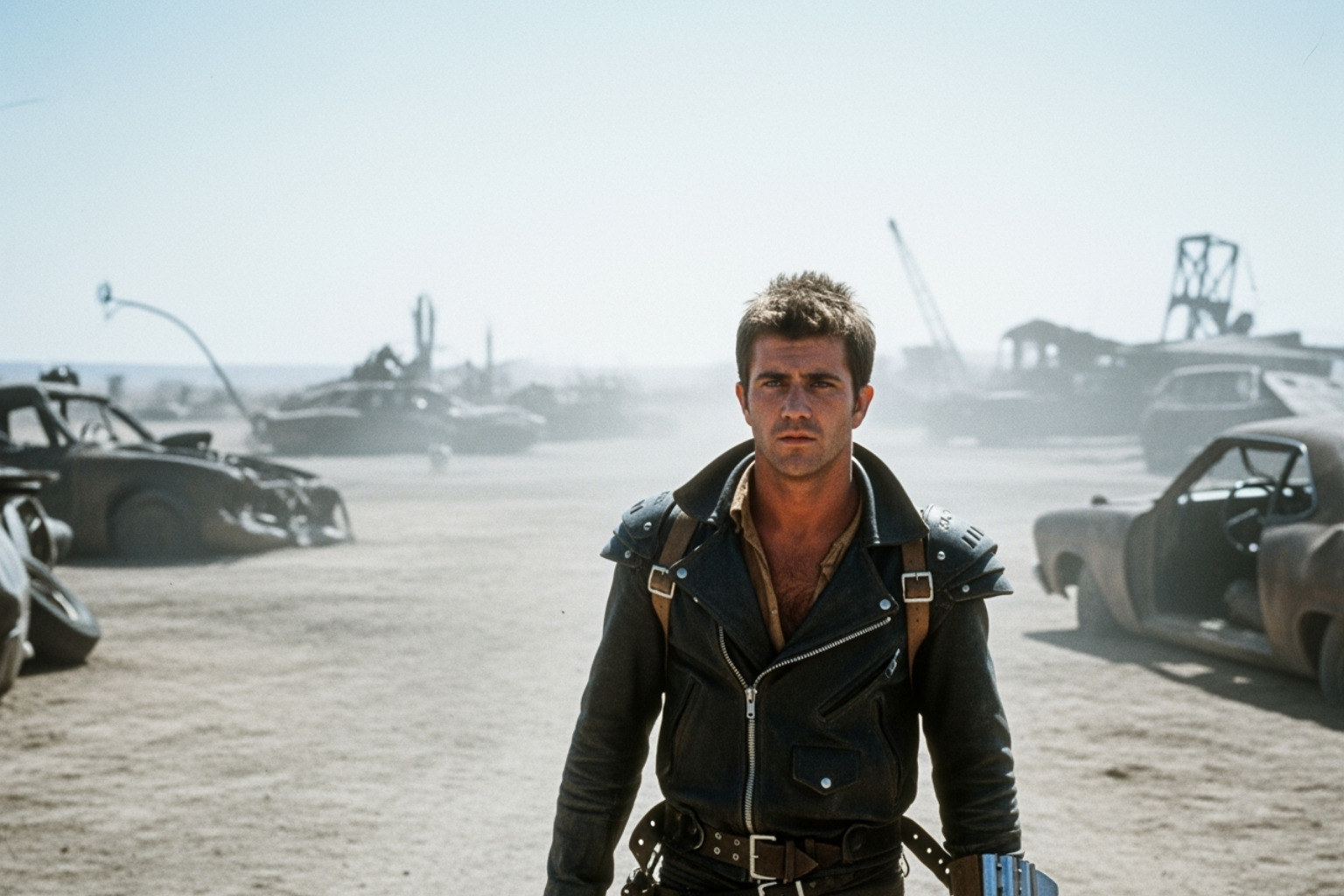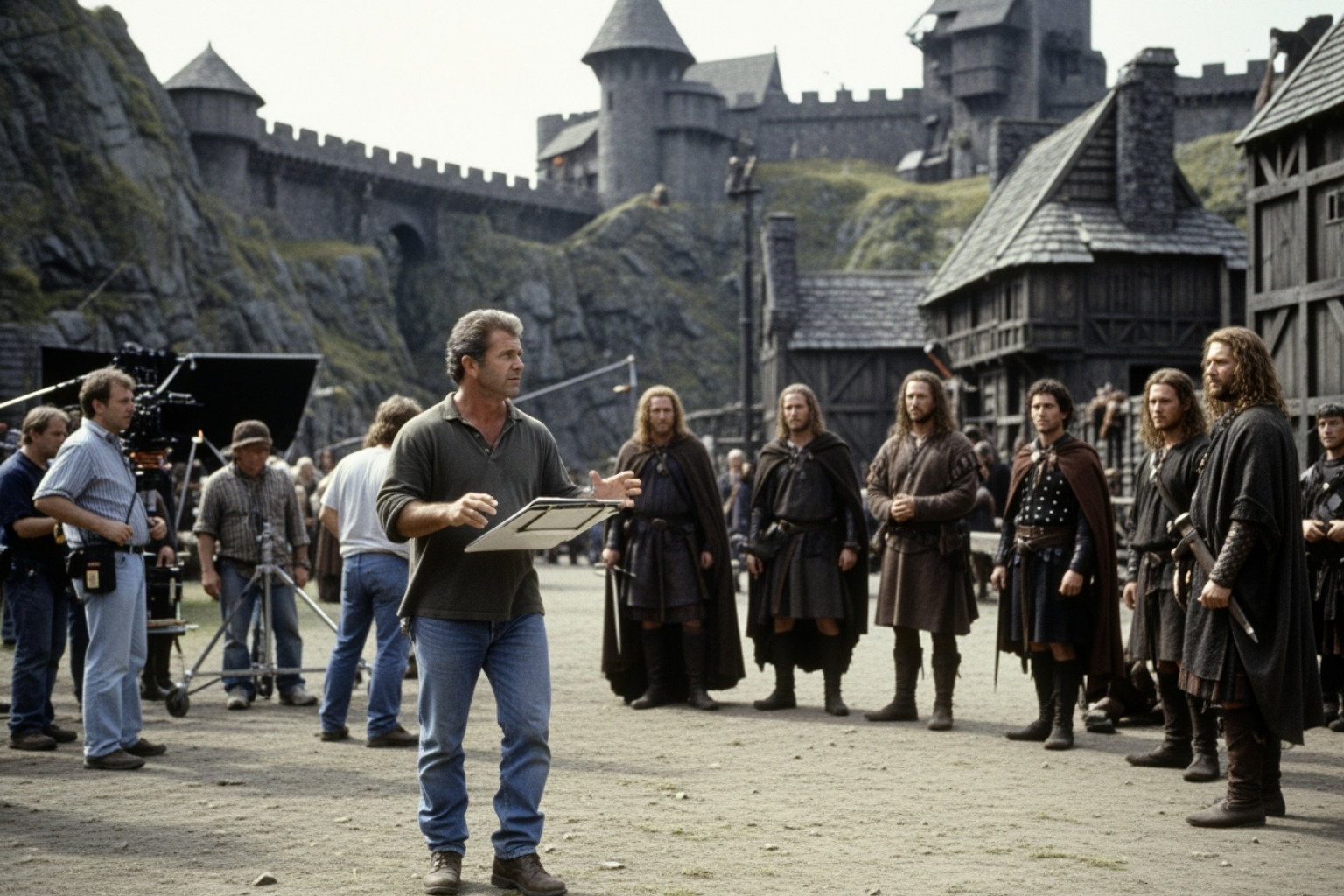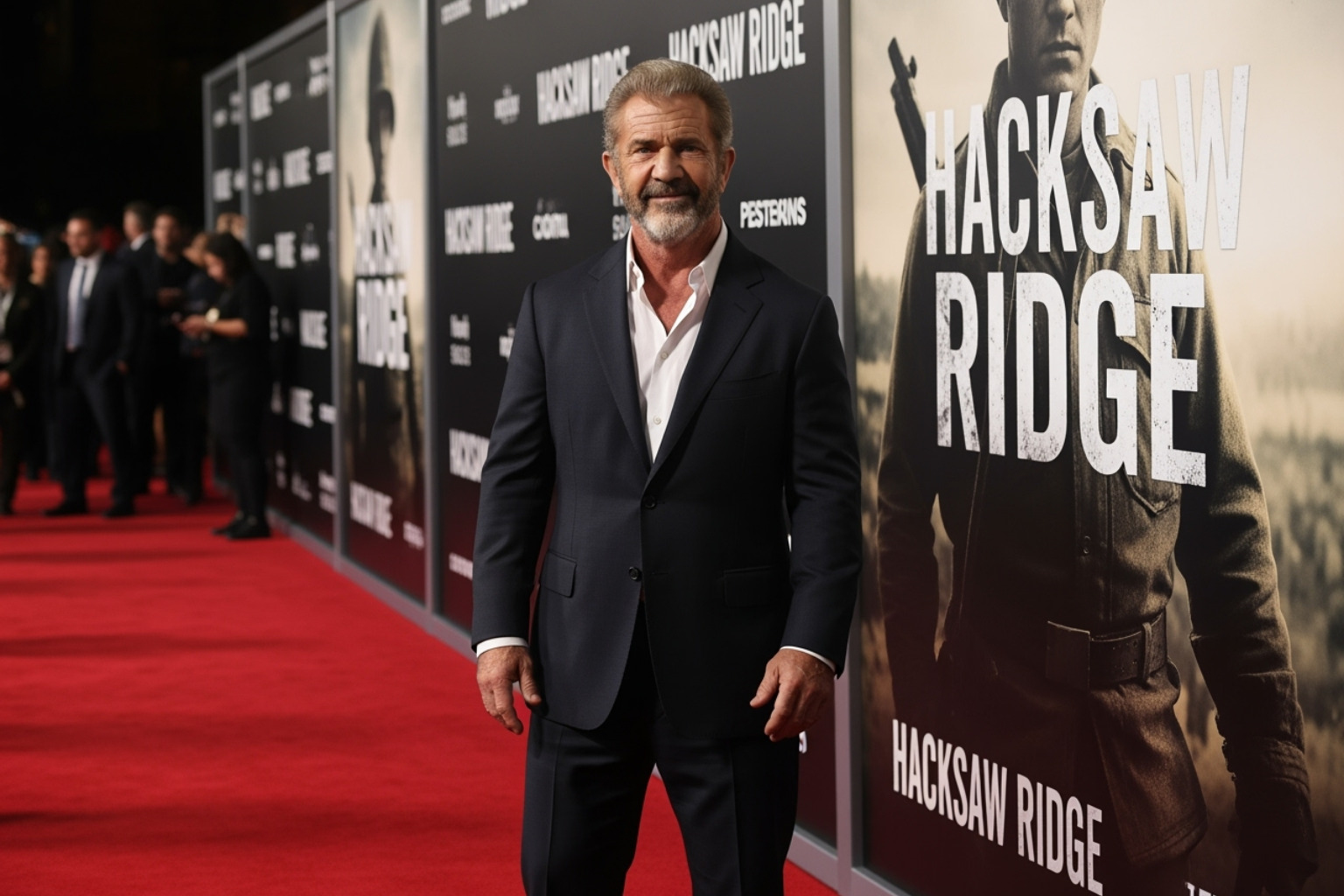From Action Hero to Oscar-Winning Director
Editor’s note: This article is a biographical profile of the individual Mel Gibson—not a guide to any specific geographic destination—so readers looking for travel information should look elsewhere.
Mel Gibson is one of Hollywood’s most complex and fascinating figures – an actor who became a global superstar before transitioning into an Academy Award-winning director. Born January 3, 1956, this American-born, Australian-raised talent has created some of cinema’s most memorable characters and films over a career spanning more than four decades.
Quick Facts About Mel Gibson:
- Born: January 3, 1956 in Peekskill, New York
- Career highlights: Mad Max, Lethal Weapon series, Braveheart, The Passion of the Christ
- Academy Awards: 2 wins (Best Picture and Best Director for Braveheart)
- Total films: 76 acting credits, 12 directing credits, 24 producing credits
- Box office success: Over $2.5 billion in combined grosses
- Highest salary: $25 million for Signs (2002)
- Personal life: 9 children, known for his Catholic faith
Gibson’s journey from $400 first film salary to Hollywood icon reflects both extraordinary talent and personal challenges. His breakout role as Max Rockatansky in Mad Max (1979) launched him to international stardom, while his portrayal of Martin Riggs in the Lethal Weapon series cemented his status as an action hero.
Behind the camera, Gibson proved equally compelling. His directorial work on Braveheart earned him two Oscars, while The Passion of the Christ became the highest-grossing R-rated film in U.S. history at $371.4 million. His career has also included significant controversies that led to professional setbacks, followed by a gradual return to mainstream filmmaking.
From his early days at Australia’s National Institute of Dramatic Art to recent projects like Hacksaw Ridge, Gibson’s story encompasses triumph, controversy, and redemption – making him one of entertainment’s most discussed figures.

The Making of an Icon: Early Life and Acting Breakthrough
Mel Gibson’s story begins far from the Australian outback that would later define his early career. Born Mel Columcille Gerard Gibson on January 3, 1956, in Peekskill, New York, he was the sixth of eleven children in a large Irish-Catholic family. His parents, Hutton Gibson and Anne Reilly, made a life-changing decision when Mel was just 12 years old.
The family packed up and moved to Sydney, Australia – reportedly funded by his father’s winnings on the game show Jeopardy! This move would prove pivotal, giving young Mel Gibson dual American and Irish citizenship while shaping his distinctly Australian identity in the film world.
His acting journey began at Sydney’s prestigious National Institute of Dramatic Art (NIDA), where he found his passion for performance. During his time there, he appeared in various stage productions, including an experimental version of A Midsummer Night’s Dream where he played Queen Titania – quite a departure from his later tough-guy roles!
His first taste of film came with the 1977 movie Summer City, which paid him a modest $400. Little did anyone know this would be the humble beginning of a career that would eventually gross over $2.5 billion worldwide.

The Rise to Fame: Iconic Mel Gibson Roles
The late 1970s marked the beginning of Mel Gibson’s meteoric rise to stardom. His breakthrough came with Mad Max (1979), where he played Max Rockatansky, a leather-clad road warrior in a post-apocalyptic wasteland. This gritty, low-budget Australian film became a global phenomenon and launched him into international stardom.
The success of Mad Max was followed by The Road Warrior (1981), which cemented his reputation as a formidable action hero. But Mel Gibson wasn’t content to be typecast. He quickly proved his dramatic chops in Peter Weir’s powerful war film Gallipoli (1981), earning an Australian Film Institute Award for Best Actor for his moving portrayal of a young soldier.
His collaboration with Weir continued with The Year of Living Dangerously (1982), where he played a journalist in Indonesia. Critics recognized this performance as the moment Mel Gibson truly arrived as a serious international actor.
However, it was his role as the unpredictable detective Martin Riggs in Lethal Weapon (1987) that made him a Hollywood heavyweight. Riggs was a complex character – part action hero, part troubled soul – and Gibson brought both intensity and vulnerability to the role. This buddy-cop franchise became a template for the genre and spawned three sequels.
Mel Gibson continued to surprise audiences by taking on Shakespeare’s Hamlet in Franco Zeffirelli’s 1990 adaptation, earning critical praise for bringing accessibility to the Danish prince. Later successes included The Patriot (2000) and M. Night Shyamalan’s Signs (2002), which became his highest-grossing film as an actor at $228.0 million.
His undeniable charisma and talent didn’t go unnoticed – People magazine named him their first “Sexiest Man Alive” in 1985, cementing his status as a Hollywood heartthrob.
From Australia to Hollywood: Building a Blockbuster Career
Mel Gibson’s journey from Australian cinema to Hollywood superstardom was remarkably swift. After his early successes, he became one of the industry’s most bankable stars, with studios eager to secure his services.
His first million-dollar salary came with Mad Max Beyond Thunderdome in 1985 – quite a leap from that initial $400 paycheck! His partnership with director Richard Donner on the Lethal Weapon series proved particularly lucrative, creating a franchise that generated massive returns for everyone involved.
By the late 1990s and early 2000s, Mel Gibson was commanding top-tier salaries. He earned a staggering $25 million for both The Patriot (2000) and Signs (2002), showcasing just how valuable studios considered him.
The financial success of his early franchises tells an impressive story:
| Franchise | Total Box Office Gross (Approx. U.S.) | Number of Films |
|---|---|---|
| Mad Max Series | $110 million | 3 (starring MG) |
| Lethal Weapon Series | $530 million | 4 |
This consistent box office performance contributed to an astonishing career total exceeding $2.5 billion in the United States alone. These numbers reflected not just his acting ability, but his unique appeal to audiences worldwide – a combination of rugged masculinity, emotional depth, and that distinctive Australian charm that made Mel Gibson one of Hollywood’s most compelling leading men.
The Auteur: Mel Gibson Behind the Camera
While Mel Gibson had conquered Hollywood as an action star, his creative vision extended far beyond acting. He founded Icon Productions, his own production company, giving him the freedom to pursue more personal storytelling projects. This move proved pivotal in his evolution from performer to filmmaker.
His directorial debut came with The Man Without a Face in 1993, a thoughtful drama that showcased his sensitivity behind the camera. The film hinted at deeper capabilities that would soon emerge in spectacular fashion. Mel Gibson had found his true calling, later explaining his passion: “I like directing much better. It’s more fun, that’s all there is to it. It’s essentially the same job, which is storytelling, but you have more control over the way you want to tell the story. It’s a high. I love it.”
This newfound passion drove him toward increasingly ambitious projects. Mel Gibson became known for his meticulous attention to historical detail and his bold decision to use authentic historical languages. His commitment to authenticity would later shine in The Passion of the Christ, where actors spoke Aramaic, Latin, and Hebrew, and in Apocalypto, filmed entirely in Yucatec Maya.

Oscar Glory with Braveheart
Mel Gibson’s directorial breakthrough came with Braveheart (1995), an epic historical drama that would define his career behind the camera. Playing William Wallace, the Scottish warrior who fought against English tyranny, Gibson initially felt too old for the role. He only agreed to star if he could also direct – a decision that changed film history.
The gamble paid off magnificently. Braveheart swept the 1996 Academy Awards, earning 10 nominations and winning 5 Oscars. Most significantly, Mel Gibson took home both Best Picture and Best Director awards, making him only the sixth actor-turned-filmmaker to achieve this honor.
The film’s success wasn’t just about awards. Gibson’s groundbreaking battle scene choreography set new standards for historical epics, while his sweeping visuals and powerful storytelling captivated audiences worldwide. Though some historians questioned certain details, the film’s emotional impact and grand scale were undeniable.
Braveheart proved that Mel Gibson possessed a rare gift for epic storytelling, combining visceral action with deep human emotion in ways that resonated with both critics and audiences.
Directorial Style and Thematic Focus of Mel Gibson
Mel Gibson’s approach to filmmaking is unmistakably his own. He brings meticulous research to every project, ensuring historical authenticity in everything from costumes to languages. His attention to detail extends beyond the technical – he’s known for using humor on set, sometimes having actors perform serious scenes with red clown noses to relieve tension during intense filming.
His directorial work explores profound themes that reflect his personal beliefs and worldview. Faith and spirituality form the cornerstone of many projects, most notably in The Passion of the Christ (2004). This deeply personal film depicted Jesus’ final hours with intense devotion and became the highest-grossing R-rated film in U.S. history at $371.4 million.
Sacrifice and redemption appear throughout his filmography. Characters in Gibson’s films endure immense suffering, making ultimate sacrifices for their beliefs or people. From William Wallace’s fight for Scottish freedom to Desmond Doss’s pacifist heroism in Hacksaw Ridge, protagonists face overwhelming odds while staying true to their convictions.
Mel Gibson doesn’t shy away from depicting violence and its consequences with unflinching honesty. His graphic realism forces audiences to confront the true cost of conflict, whether in medieval Scotland or ancient Mayan civilization. This visceral approach serves his storytelling by making the stakes feel immediate and real.
His films often explore the eternal struggle between good and evil, presenting characters caught between these forces. In Apocalypto (2006), a young man fights desperately for survival against the backdrop of a collapsing civilization, while Hacksaw Ridge (2016) shows how one man’s faith can triumph over the brutality of war.
These themes, combined with his distinctive visual style and ability to draw powerful performances from actors, make Mel Gibson’s directorial work both compelling and memorable. His commitment to authentic storytelling continues to influence filmmakers and captivate audiences worldwide.
Controversy, Comeback, and Personal Change
The story of Mel Gibson took a dramatic turn in 2006, when a DUI arrest led to widely reported antisemitic remarks that shocked Hollywood and the public. This incident marked the beginning of one of the most challenging periods in his career. The situation worsened when leaked audio recordings from a domestic dispute revealed racist and misogynistic comments, creating a storm of controversy that would follow him for years.
The fallout was swift and severe. Major studios distanced themselves from the once-beloved star, and former collaborators stepped away. What many described as an industry “blacklisting” meant that Mel Gibson struggled to find mainstream opportunities as both an actor and director. The man who had once commanded $25 million per film found himself largely shut out of the Hollywood system he had helped define.
This period of exile lasted nearly a decade, during which Gibson faced intense public scrutiny, legal battles, and personal challenges. It was a stark reminder of how quickly a career built over decades can change when personal actions clash with public expectations.

The Road to Redemption and Recent Work
The path back to Hollywood wasn’t easy, but Mel Gibson began his slow return with help from unexpected allies. Director Jodie Foster stood by him, casting him in The Beaver (2011), a drama that marked his first major film after the controversies. While the movie didn’t set the box office on fire, it represented an important first step.
The real breakthrough came with Hacksaw Ridge in 2016. This powerful war film about conscientious objector Desmond Doss proved that Gibson’s directing talents remained sharp. The movie earned widespread critical praise and brought in $164 million worldwide against a $40 million budget. More importantly, it earned him a Best Director nomination at the 2017 Academy Awards – a clear signal that Hollywood was ready to acknowledge his work again.
Since then, Mel Gibson has steadily returned to acting, taking on roles in films like Daddy’s Home 2, Dragged Across Concrete, and Fatman. Not every project has been a hit – his 2023 film Confidential Informant received harsh reviews – but his persistence shows a man committed to his craft despite past setbacks.
Health, Wellness, and Family Life
Behind the public comeback, Mel Gibson’s personal journey has been equally transformative. As a father of nine children, his family life has evolved significantly over the years. His marriage to Robyn Moore ended in 2011 with one of Hollywood’s largest divorce settlements, reportedly exceeding $400 million. He later had a relationship with Oksana Grigorieva and is now in a long-term partnership with Rosalind Ross, with whom he has another child.
Perhaps most importantly, Gibson has addressed his struggles with alcohol abuse – a key factor in his public incidents. His commitment to sobriety represents a crucial part of his personal growth journey. Like many people working toward wellness, he’s found that real change requires ongoing dedication and support.
His approach to physical health has been equally impressive. In 2018, at age 62, he worked with Perth-based health coach Sam Jackson to lose 14kg and 27cm from his waistline in just eight weeks. Through healthier eating habits and consistent support, he improved his sleep, relieved back pain, and felt better overall. “At least I fit in the mirror!” he joked about the change.
This dedication to wellness extends beyond personal health. Gibson has contributed to charitable causes, including a $500,000 donation to the El Mirador Basin Project supporting conservation efforts in Guatemala. His strong Catholic faith continues to influence both his personal life and his work, particularly evident in The Passion of the Christ.
Mel Gibson’s journey reminds us that personal change is always possible, no matter how challenging the circumstances. His story of rebuilding – both professionally and personally – shows that with commitment and support, people can work toward becoming their best selves. At Beyond Beauty Lab, we believe in this same philosophy: that wellness is a continuous journey of growth and positive change.
What’s Next for a Hollywood Legend?
At 68 years old, Mel Gibson shows no signs of slowing down. His journey from action star to Oscar-winning director, through controversy and back to industry respect, has created one of Hollywood’s most fascinating career arcs. Today, he stands as a complex figure whose talent has never been in question, even as his personal struggles became public knowledge.
His evolving legacy reflects both extraordinary artistic achievement and human imperfection. The man who gave us unforgettable characters like Max Rockatansky and William Wallace has also shown us that redemption is possible through dedication to personal growth and professional excellence. Much like the transformative journeys we champion at Beyond Beauty Lab, Mel Gibson’s story reminds us that change and renewal are always within reach.
The industry has largely welcomed him back, particularly after the critical and commercial success of Hacksaw Ridge. His ability to craft powerful, visceral stories remains undiminished, and audiences continue to respond to his unique directorial vision. Whether behind the camera or in front of it, he brings an intensity and authenticity that few filmmakers can match.
Confirmed and Rumored Future Projects
Mel Gibson has several exciting projects lined up that showcase his continued relevance in modern Hollywood. His upcoming thriller Flight Risk marks his return to the director’s chair, starring Mark Wahlberg in what promises to be another intense, character-driven story. This collaboration with Wahlberg, known for his own commitment to fitness and wellness, suggests Gibson is working with actors who share his dedication to their craft.
The long-awaited Lethal Weapon 5 remains a tantalizing possibility. Fans have been hoping to see Gibson return as Martin Riggs, potentially stepping behind the camera to direct this final chapter in the beloved franchise. The project would bring full circle his relationship with the character that defined much of his early career.
Perhaps most intriguing is The Passion of the Christ: Resurrection, the sequel to his controversial but massively successful 2004 film. This project reflects his continued exploration of faith and spirituality, themes that have become central to his directorial work. Given the original film’s $371.4 million domestic gross, anticipation runs high for this follow-up.
Mel Gibson is also attached to direct a remake of the classic Western The Wild Bunch, a project that would allow him to revisit themes of violence, loyalty, and redemption that have defined much of his work. Additionally, Boys of Summer appears among his upcoming acting credits, suggesting he’s balancing directorial ambitions with his continued screen presence.
These projects demonstrate that Mel Gibson remains committed to both sides of the camera. His future in Hollywood looks bright, built on a foundation of proven talent and hard-won wisdom. Like any meaningful change, his journey continues to evolve, offering new chapters in an already remarkable story.
Frequently Asked Questions about Mel Gibson
What is Mel Gibson’s most successful film?
The answer depends on whether we’re looking at Mel Gibson as an actor or director. His biggest box office hit as an actor was Signs (2002), M. Night Shyamalan’s supernatural thriller that earned him a massive $25 million paycheck and brought in $228.0 million at the domestic box office.
But it’s his work behind the camera that truly broke records. The Passion of the Christ (2004) became Mel Gibson’s most successful directorial effort, earning an incredible $371.4 million in the U.S. alone. This made it the highest-grossing R-rated film at the time of its release – a record that stood for years.
What makes this achievement even more remarkable is that the film was shot entirely in ancient languages like Aramaic, Latin, and Hebrew, with subtitles throughout. Many industry experts predicted it would be a commercial disaster, but Mel Gibson’s vision connected with audiences worldwide.
How many Oscars has Mel Gibson won?
Mel Gibson has won two Academy Awards, both for his epic historical drama Braveheart in 1996. He took home Best Picture as the film’s producer and Best Director for his work behind the camera. This made him only the sixth actor-turned-filmmaker to win the Academy Award for Best Director.
His Oscar journey didn’t end there. After years of controversy and career setbacks, he earned another nomination for Best Director in 2017 for Hacksaw Ridge. This nomination was particularly meaningful as it marked his return to Hollywood’s good graces after nearly a decade of being largely shut out of major projects.
Throughout his career, Mel Gibson has accumulated an impressive 46 wins and 48 nominations across various awards ceremonies, showing just how respected his work has been in the industry.
Is Mel Gibson Australian?
This is one of the most common misconceptions about Mel Gibson. While he’s strongly associated with Australia and launched his career there, he was actually born in Peekskill, New York, on January 3, 1956.
The confusion comes from his formative years. When Mel Gibson was 12 years old, his family moved to Sydney, Australia – reportedly funded by his father’s winnings on the game show Jeopardy! He completed his education there and studied acting at the prestigious National Institute of Dramatic Art (NIDA).
His early breakthrough roles in Mad Max and Gallipoli were Australian productions, which cemented his image as an Aussie actor in many people’s minds. Today, he holds both American and Irish citizenship, but Australia will always be the place where his legendary career truly began.
Conclusion
Mel Gibson’s story reads like a Hollywood script itself – complete with soaring triumphs, devastating falls, and a hard-fought journey back to redemption. From his breakout role as the leather-clad Max Rockatansky to his Oscar-winning directorial triumph with Braveheart, he proved that raw talent and unwavering vision could conquer the entertainment world.
His career has been a masterclass in extremes. The same man who charmed audiences as the wise-cracking Martin Riggs also created some of cinema’s most unflinching explorations of faith and sacrifice. Yet his professional heights were matched by equally dramatic personal lows – public controversies that seemed to end his Hollywood story entirely.
What makes Mel Gibson’s journey so compelling isn’t just the comeback itself, but how it happened. His return required genuine personal change, including a commitment to sobriety and wellness that changed him from the inside out. When he shed 14kg and transformed his health at age 62, it wasn’t just about fitting into his clothes better – it was about rebuilding his entire life foundation.
This narrative of personal change resonates deeply with our mission at Beyond Beauty Lab. We understand that true wellness isn’t just about surface changes – it’s about the courage to face your challenges head-on and commit to genuine growth. Mel Gibson’s story reminds us that it’s never too late to prioritize your health and well-being.
As he continues working on projects like Flight Risk and The Passion of the Christ: Resurrection, Gibson’s legacy remains complex but undeniably powerful. His journey from action hero to acclaimed director, through controversy and back to respected filmmaker, shows us that change is always possible when we’re willing to do the work.







